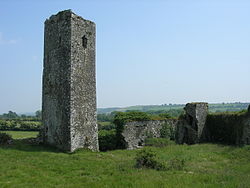Ballincollig
|
Ballincollig Baile an Chollaigh |
|
|---|---|
| Town | |

Ballincollig Castle
|
|
| Location in Ireland | |
| Coordinates: 51°53′16.54″N 8°35′21.44″W / 51.8879278°N 8.5892889°WCoordinates: 51°53′16.54″N 8°35′21.44″W / 51.8879278°N 8.5892889°W | |
| Country | Ireland |
| Province | Munster |
| County | County Cork |
| Dáil Éireann | Cork North-West |
| Elevation | 70 ft (20 m) |
| Population (2011) | |
| • Total | 17,368 |
| Time zone | WET (UTC+0) |
| • Summer (DST) | IST (WEST) (UTC-1) |
| Eircode (Routing Key) | P31 |
| Irish Grid Reference | W5957077 |
Ballincollig (Irish: Baile an Chollaigh) is a satellite town and largest town in County Cork, Ireland, approximately 9 km west of Cork city. It is located beside the River Lee on the R608 regional road. In 2011 the population of Ballincollig DED was 17,368. The nearest towns include: Ballinora, Carrigohane, Kilnaglory, Ovens, Killumney, Inniscarra, Blarney (home of the Blarney Stone), and Tower. It is located beyond the Green Belt from the Cork city suburbs of Bishopstown and Wilton. Many of the people from Ballincollig commute to the city for work. It is a mainly residential town.
The Barrett family (after whom the barony which contains Ballincollig is named) built Ballincollig Castle during the reign of Edward III. The castle was taken from Andrew Barrett by rebels in 1641, but they were expelled by English Parliamentary forces under Murrough O'Brien, Earl Inchiquinn, in 1645. It was garrisoned for James II in 1689, during the Williamite war in Ireland, then remained unoccupied after his defeat, and fell into decay.
The Ballincollig Royal Gunpowder Mills were opened in 1794 by Charles Henry Leslie, a prominent Cork businessman. Eleven years later, the mills were bought by the British, who were preparing for war with Napoleon, and the barracks were built to protect the supply of gunpowder. It was one of the largest gunpowder mills in the British Isles. In 1837, the mill employed several hundred workers, and by 1880, Ballincollig was one of the largest industrial establishments in Cork, with the mill employing many men and boys from the area.
...
Wikipedia

